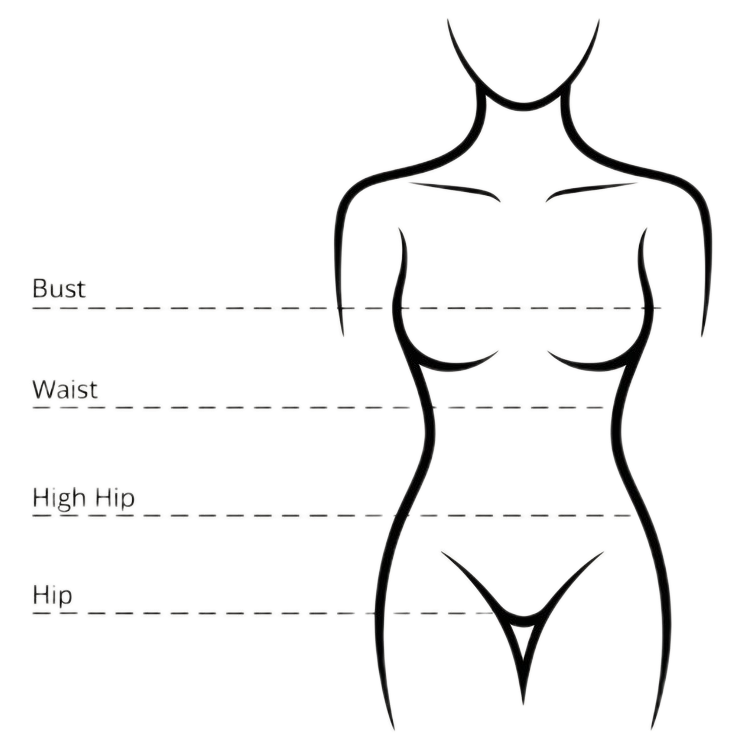Body Type Calculator
Enter Your Measurements
Measurement Tips

Stand straight with arms to the side. Make sure the tape is snug against the body, but not too tight.
Bust size—the circumference measured around the chest over the fullest part of the breasts, while wearing a properly fitted bra.
Waist size—the smallest circumference measured around the natural waist, just above the belly button.
High hip size—the circumference of the upper swell of the hip over the pelvic region. It is around 7 inches (18 cm) below the natural waist.
Hip size—the largest circumference measured around the hips over the largest part of the buttocks.
What is the Body Type Calculator?
The Body Type Calculator is designed for females to find their 'body shape,' which can be used for getting targeted outfit ideas. Even though there is some research linking certain body shapes with some health risks, the body shape result of this calculator is not intended to be a serious indication of health or an ideal that must be met.
Instead, the waist-hip ratio, which is also shown in the results of this calculator, is a better indicator of health.
Female Body Shapes in the Fashion Industry
In the fashion industry, body shapes are often categorized into several classes to help with clothing selection and style recommendations.
Common Body Shapes
- Hourglass - Hip and bust measurements nearly equal in size, with a narrower waist measurement.
- Bottom Hourglass - Hips larger than bust, with a well-defined waist.
- Top Hourglass - Bust larger than hips, with a well-defined waist.
- Spoon - Hips larger than bust with a defined waist and high hip/waist ratio.
- Triangle (Pear) - Hip measurements greater than bust measurements with a less defined waist.
- Inverted Triangle (Apple) - Broader shoulders and bust than hips with a less defined waist.
- Rectangle (Banana) - Waist measurements less than 9 inches smaller than hip or bust measurements.
How Body Shape is Calculated
The algorithm used in this calculator is based on a study published in the International Journal of Clothing Science and Technology, which breaks down the body shapes of women into 7 categories.
Body Shape Formulas
Hourglass: If (bust - hips) ≤ 1" AND (hips - bust) < 3.6" AND (bust - waist) ≥ 9" OR (hips - waist) ≥ 10"
Bottom Hourglass: If (hips - bust) ≥ 3.6" AND (hips - bust) < 10" AND (hips - waist) ≥ 9" AND (high hip/waist) < 1.193
Top Hourglass: If (bust - hips) > 1" AND (bust - hips) < 10" AND (bust - waist) ≥ 9"
Spoon: If (hips - bust) > 2" AND (hips - waist) ≥ 7" AND (high hip/waist) ≥ 1.193
Triangle: If (hips - bust) ≥ 3.6" AND (hips - waist) < 9"
Inverted Triangle: If (bust - hips) ≥ 3.6" AND (bust - waist) < 9"
Rectangle: If (hips - bust) < 3.6" AND (bust - hips) < 3.6" AND (bust - waist) < 9" AND (hips - waist) < 10"
Waist-Hip Ratio and Health
Waist-hip ratio (WHR) is defined as the ratio of waist circumference to hip circumference. The value is calculated by dividing waist measurement by hip measurement.
Research has shown that people with more weight around their waist ('apple-shaped' bodies) are at higher risk than those with more weight around their hips ('pear-shaped' bodies).
According to health organizations, women with WHRs above 0.85 and men with WHRs above 1.0 have higher health risks related to their fat distribution.
How to Use This Calculator
- Take accurate measurements of your bust, waist, high hip, and hip circumferences.
- Enter these measurements in the calculator using your preferred units (inches or centimeters).
- Click the 'Calculate' button to determine your body shape and waist-hip ratio.
- Review your results to understand your body shape for fashion purposes and your waist-hip ratio for health considerations.
Frequently Asked Questions
What is the most common female body shape?
According to a study of more than 6,000 women conducted at North Carolina State University in 2005, the most common body shape was the Rectangle (about 46%), followed by the Pear/Triangle shape (about 20%), then Apple/Inverted Triangle (about 14%), with the Hourglass shape being the least common (only about 8%).
Can my body shape change over time?
Yes, your body shape can change due to factors like weight fluctuations, aging, pregnancy, hormonal changes, and exercise routines. However, the basic skeletal structure that influences your body shape remains relatively constant.
Is one body shape healthier than others?
Body shape alone is not a definitive indicator of health. However, research suggests that having more weight around the waist (higher waist-hip ratio) may be associated with increased health risks compared to having weight distributed around the hips. The waist-hip ratio is a better health indicator than body shape alone.
How accurate is this calculator?
This calculator uses established formulas based on academic research to determine body shapes. However, it's important to remember that body shapes exist on a spectrum, and some people may fall between categories. The calculator provides a general classification rather than an absolute determination.
Can men use this body type calculator?
This calculator is specifically designed for female body shapes as used in the fashion industry. Men typically have different body shape classifications and proportions. For men, other measurements like shoulder width would be more relevant.